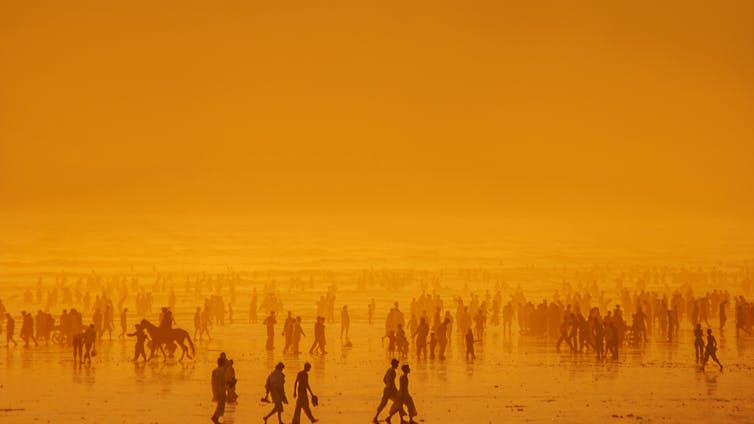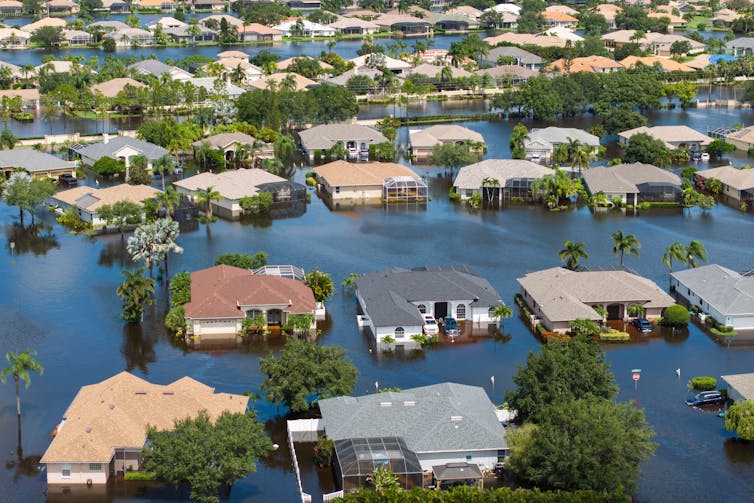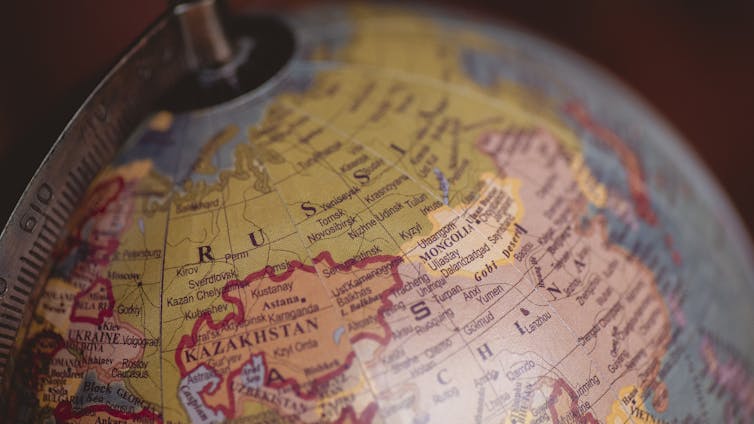 |
| Still from Vie Privee - Jodie Foster |
Evaluation:
 |
| Still from Vie Privee - Jodie Foster |
Evaluation:
 |
| Mr Nobody against Putin - Pavel Talakin |
Russian school teacher, Pavel "Pasha" Talakin enjoyed his job teaching at a primary school in the small Russian town of Karabash, famous only for its polluting copper smelter, the largest in Russia. Everything changed when Russia invaded Ukraine and the war began. The Russian state started to increasingly intervene into the curriculum and classrooms promoting nationalism and the war to the dismay of Talakin. Determined to ensure this situation was both documented and opposed, Talakin filmed the events as they occured eventually leading to police surveillance of his activities until he was forced to flee his country.
His film documents the progressive requirements placed on teachers to recite propaganda against the West and Ukraine, the institution of military training for children and the shock appearance of uniformed Wagner mercenaries to provide weapons instruction to the school children. As the timeline of the film progresses, the sadness of former school graduates being killed in action in the war emerges. This is a heartfelt, sentimental and personal voyage documented by Talakin and serves again to reinforce the tragedy that authoritarian regimes can inflict on their communities.
Often filmed using a handheld camera, the documentary had post production assistance including historical footage added once Talakin reached the West.
Evaluation:
 |
| Still from The Golden Spurtle |
The Sydney Film Festival is currently running in Sydney from the 4th to the 15th June 2025. Now in its 72nd year, the festival has continued to develop and consolidate as a multi-venue event and at various times has between 13 and 18 venues screening films simultaneously. Traversing across various genres, the films are mainly recent and new releases with additional retrospective programs focussed on one particular film director (this year its American director, Elaine May) and specialist restoration films (this year, "Classics Restored").
The festival website: Sydney Film Festival

Is climate action a lost cause? The United States is withdrawing from the Paris Agreement for the second time, while heat records over land and sea have toppled and extreme weather events have multiplied.
In late 2015, nations agreed through the Paris Agreement to try to hold warming well under 2°C and ideally to 1.5°C. Almost ten years later, cutting emissions to the point of meeting the 1.5°C goal looks very difficult.
But humanity has shifted track enough to avert the worst climate future. Renewables, energy efficiency and other measures have shifted the dial. The worst case scenario of expanded coal use, soaring emissions and a much hotter world is vanishingly unlikely.
Instead, Earth is tracking towards around 2.7°C average warming by 2100. That level of warming would represent “unprecedented peril” for life on this planet. But it shows progress is being made.
Global greenhouse gas emissions have risen since industrialisation began around 1850. Carbon dioxide (CO₂) is far and away the most common greenhouse gas we emit, while methane and nitrous oxide also play a role. These gases trap the sun’s heat in the atmosphere, preventing it from radiating back out to space.
In 2023, 41% of the world’s energy-related CO₂ emissions came from coal, mainly for electricity generation. Some 32% came from burning oil in road vehicles, and 21% from natural gas used for heating buildings and industrial processes.
The world is certainly feeling the effects. The World Meteorological Organization confirmed 2024 was the hottest year on record, temporarily hitting 1.5°C over the pre-industrial era. In turn, the world suffered lethal heatwaves, devastating floods and intense cyclones.

In 2014, the world’s peak body for assessing climate science – the Intergovernmental Panel on Climate Change – began using four scenarios called Representative Concentration Pathways (RCPs). These four big picture climate scenarios are based on what actions humanity does or doesn’t take. They comprise:
The numbers refer to how many more watts of heat strike each square metre of the planet.
Of these four, only the RCP 2.6 scenario is compatible with the Paris Agreement’s goal of holding climate change well under 2˚C.
But Earth is tracking towards somewhere between RCP 2.6 and 4.5, which would translate to about 2.7°C of warming by 2100.
IPCC experts also developed five pathways of possible social, economic and political futures to complement the four scenarios.
Of these pathways, we are tracking closest to a middle of the road scenario where development remains uneven, the intensity of resource and energy use declines, and population growth levels off.
While effective, these scenarios are now more than a decade old and need to be updated. In response, my colleagues and I produced the One Earth Climate Model to outline rapid pathways to decarbonise. We set an ambitious carbon budget of 450 gigatonnes of CO₂ before reaching net zero – a pathway even more ambitious than the RCP 2.6.
The US, European Union and China together represent about 28% of the global population, but are responsible for 56% of historic emissions (926 gigatonnes) . The pathways compatible with 1.5°C give them a remaining carbon budget of 243 Gt CO₂. China would require the largest carbon budget to reach decarbonisation.
For this to happen, by 2050, the world would have to be 100% powered by clean sources and phase out fossil fuel use. This would limit global warming to around 1.5°C, with a certainty of just over 50%. We would also have to end deforestation within the same timeframe.
Emissions of carbon dioxide and other greenhouse gases have still not plateaued, despite sharply increasing renewable electricity generation, battery storage and lower-cost electric vehicles.
But there has been real progress. The EU says its emissions fell by 8.3% in 2023 compared to 2022. Europe’s net emissions are now 37% below 1990 levels, while the region’s GDP grew 68% over the same period. The EU remains on track to reach its goal of reducing emissions by at least 55% by 2030.
Australia’s emissions fell by 0.6% last year. The country is now 28.2% below June 2005 levels, which is the baseline set for its Paris Agreement goal of a 43% reduction by 2030.
In the US, emissions are still below pre-pandemic levels and remain about 20% below 2005 levels. Since peaking in 2004, US emissions have trended downward.
The world’s largest emitter, China, is finally cutting its emissions. Huge growth in renewables has now led to the first emissions drop on record, despite surging demand for power. This is good news. For years, China’s domestic emissions remained high despite its leading role in solar, wind, EVs and battery technology.
China produces almost one-third (31%) of the world’s energy-related carbon emissions – not least because it is the workshop of the world. Every cut China makes will have a major global effect.
According to the IPCC, limiting warming to around 1.5°C requires global emissions to peak before 2025 at the latest. It now looks like the peak may occur this year.
Despite daily negative news, the decarbonisation train has left the station. In 2024, renewables accounted for more than 90% of growth in electricity production globally. Electric vehicles became cost competitive, while heat pumps are developing fast and solar is on a winning streak.
So, is it too late to save the climate? No. The technologies we need are finally cheap enough. The sooner we stop climate change from worsening, the more disasters, famine and death we avert. We might not manage 1.5°C or even 2°C, but every tenth of a degree counts. The faster we make the shift, the better our climate future.![]()
Sven Teske, Research Director, Institute for Sustainable Futures, University of Technology Sydney
This article is republished from The Conversation under a Creative Commons license. Read the original article.

Russia’s possible interest in basing long-range aircraft at an Indonesian airbase not far from Australian shores shook up a relatively staid election campaign last month.
The news, which Jakarta immediately dismissed, caught many by surprise in Australia. It shouldn’t have. While Indonesia’s non-aligned stance makes granting such a request highly unlikely, Russia’s defence and political ties with Southeast Asia have actually been deepening over the last decade, at least.
All of this has gone largely unnoticed in Australia. And this highlights a significant problem: Australia has something of a knowledge deficit when it comes to Russia. This is in part due to the fact our expertise on the country has been hollowed out since the Cold War ended.
The Soviet Union loomed large in Australia’s consciousness during the Cold War, if not high on its list of priorities.
Today, Russia remains a major, albeit slightly diminished, power. It is a nuclear weapons state (it has more than 5,500 nuclear warheads, the most of any nation) and a permanent member of the United Nations Security Council. It is also active in other forums of importance to Australia, such as the G20 and APEC, as well as in issues like arms control and climate change.
Most worryingly, under President Vladimir Putin, Russia will no doubt continue to be a disruptor on the international stage.
Russia’s political and security elite perceive the country to be a great power with interests and a right to influence in every part of the world. Just to drive that message home, a giant sign quoting Putin last year read: “Russia’s borders do not end anywhere”.
Even before its full-scale invasion of Ukraine in 2022, Moscow perpetuated an ideology that it is at war with the West. This idea is a key source of legitimacy for Putin’s regime. Russia’s hostile actions against Western democracies continue to proliferate. These include disinformation campaigns, cyber attacks, election interference and, in some regions, sabotage and assassinations.
This isn’t focused entirely on Europe and the US, either. Russia has an active – and expanding – military presence in the Asia-Pacific. Russia’s Pacific Fleet, based in Vladivostok, now has more than 20 nuclear and conventional submarines and frequently engages in training exercises with the Chinese navy.
More “normal” relations with Russia will not return soon. A lasting peace in Ukraine seems unlikely if any interim ceasefire deal leaves large swathes of the country under a brutal Russian occupation regime. Putin is unlikely to let go of his ambitions to subjugate Ukraine and limit its independence.
While sanctions have made it harder for Moscow to conduct the war, the Russian economy also does not appear in danger of imminent collapse.
Meanwhile, Southeast Asia has proven susceptible to Russia’s anti-Western narratives, particularly when it comes to the claim that the Russian invasion was provoked by Western policies and threats. Most regional governments have been loathe to criticise the invasion and the leaders of Indonesia and Malaysia have made state visits to Moscow despite it.
Russia has had similar success in pushing disinformation through orchestrated social media campaigns across the Global South, including in parts of Africa where Australian companies have made significant investments in the mining sector.
All these trends point to the need to enhance Australia’s modest level of Russia literacy, both in language skills and broader country expertise.
This was the key message of a recent conference on “Russian activities and Australian interests in the Indo-Pacific”, hosted by the ANU’s Centre for European Studies. It was attended by a wide range of government officials, academics, analysts and foreign diplomats.
Australia once had strong Russian-language departments at several universities. It also boasted numerous Russian and Soviet scholars of global repute, such as Harry Rigby, Sheila Fitzpatrick, Graeme Gill, Stephen Wheatcroft, Geoffrey Jukes and Stephen Fortescue.
Today, the number of university departments teaching Russian language, history or politics has dwindled, with only the University of Melbourne offering a major in Russian language and literature. That university has also added a much-welcomed fellowship in Ukrainian studies.
And Australia has few lecturers or researchers in international relations, history or social sciences with Russia expertise, including language skills.
We can – and should – return our university Russian offerings to the levels we had 30 years ago. This can be done without cutting back on the existing expansive focus on other countries and regions. There is also scope for greater focus on Russia and the former Soviet countries in government.
It will hard for Russia to shake off the pattern of failed government reform efforts defaulting to strong, centralised rule with imperial ambitions and an anti-Western posture.
But moves towards reform could eventually bear fruit (again) when Putin leaves the stage. If this were to happen, Russia would remain a major power with a rich cultural legacy and many common interests with Australia in areas such as natural resources. There is also a significant Russian diaspora in Australia.
For Australia, it is a mistake to think of Russia as somewhere far away. Both in simple geography – all state capitals except Perth are closer to Vladivostok than to New Delhi – and in terms of the interplay of global interests.
Or, as British commentator Keir Giles puts it: “You may not be interested in Russia, but Russia is interested in you.”![]()
Jon Richardson, Visiting Fellow, Centre for European Studies, Australian National University
This article is republished from The Conversation under a Creative Commons license. Read the original article.